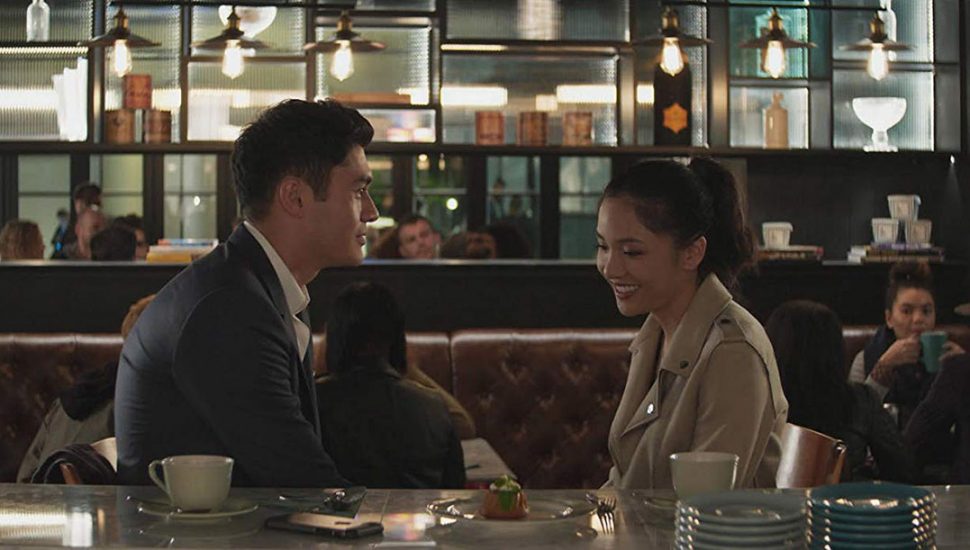
Everything about before the couple’s arrival in Singapore feels rushed but it’s a gambit that works for the most part because Jon M Chu’s direction immediately picks up when they touch down. With a title like Crazy Rich Asians, the film’s production design never falters in projecting the requisite wealth of the elites in Singapore. The film is visually plush and ornate from its production design to its costumes, which seem pointedly expressive for a contemporary film. There’s a climactic wedding sequence that’s so luxurious it feels almost obscene.
Crazy Rich Asians’ place as the first American film in a generation to feature a complete cast of Asian descent has been the lede in most of the coverage about it, so the marriage of its Asian roots with its decadent wealth seems especially significant. Crazy Rich Asians offers a world of grandiose wealth that in Hollywood has almost always been identified with a tradition of whiteness. The idea of the very wealthy in Asia is not a new or even unusual one, but its representation in Hollywood as the subject and not the object of an entire film is. The proximity of these (mostly) Chinese actors with this sort of contemporary wealth feels like a necessary risk in contemporary Hollywood. But, the film’s engagement with that wealth seems to take fewer risks.
With only three characters (only two of them major ones) being members of the “middle” class, the film’s engagement with wealth and class in the 21st century becomes oddly, or perhaps expectedly, bland. Inasmuch as the film presents Rachel’s dilemma of assimilating with the Nick’s very rich family to be the crux of their idealistic romance, Crazy Rich Asians seems to exist in an almost fantasy world where the cultural and political implications of all that wealth seem to be ignored. And it feels particularly significant when its protagonist is an economics professor, who seems to have nothing incisive to say about the development of economics in Singapore in relation to race and class.
It’s why I keep thinking about the brief scene that opens the film. It’s the only one in the film that is dominated by a non-Asian performer. At an American hotel, in the mid-nineties, an Asian mother and her two children arrive wet and bedraggled for a hotel they booked. The concierge can barely hide his racist revulsion and claims no rooms are available, but a quick plot twist reveals the humour. This woman (Michelle Yeoh in excellent form as Eleanor Young, Nick’s mother) has recently become the First Lady of the hotel. Her husband has just bought the property. And so, the racist staff must now genuflect to the woman they were insulting only moments before. The scene feels excisable in the larger mythology of Crazy Rich Asians. The characters in this film do not exist in relation to whiteness and the moment does not further the narrative in any key way. Eleanor’s skirmishes with racism from white Americans is never touched on again and so the scene feels peripheral.
And yet, as I begin to consider the film’s odd lack of nuance on the real class and power structures in Singapore, the scene begins to make sense, even if retroactively. Perhaps we’re meant to read everything that comes after in relation to that scene. The effusive and almost unnecessary decadence of these crazy-rich (and not crazy comma rich) Asians seems pointed when measured in relation to the racism of the white western world. Is it enough? Probably not, but is there a need for the film to offer incisive commentary on wealth? Definitely not. It’s the burden of underrepresented groups in media that we unfairly hope a single piece of art can represent all things for all persons. It’s an untenable situation.
As a heavy-handed throwback to the glitz and glamour of 1940s romances, Crazy Rich Asians succeeds. The fact that the film does not engage much with the history of Asia is interesting but not troublesome. Beyond some random moments of dumpling making, the film does not focus on the traditions of China and Singapore in any overt way. But the film is charming and winning and the brief set-up for a sequel in the final moments of a mid-credits scene are sweet. Its entire existence is ensconced in wealth in a way that makes it seem more fantasy than reality. And, perhaps, that’s the point. Crazy Rich Asians is not about real-world politics and economics but is instead a fairy-tale romance of a regular woman thrust into the world of the rich elite. And it’s a great fairy-tale.
(Email your questions or comments to Andrew at almasydk@gmail.com)
Crazy Rich Asians is currently playing at Princess Movie Theaters and Caribbean Cinemas Guyana.






